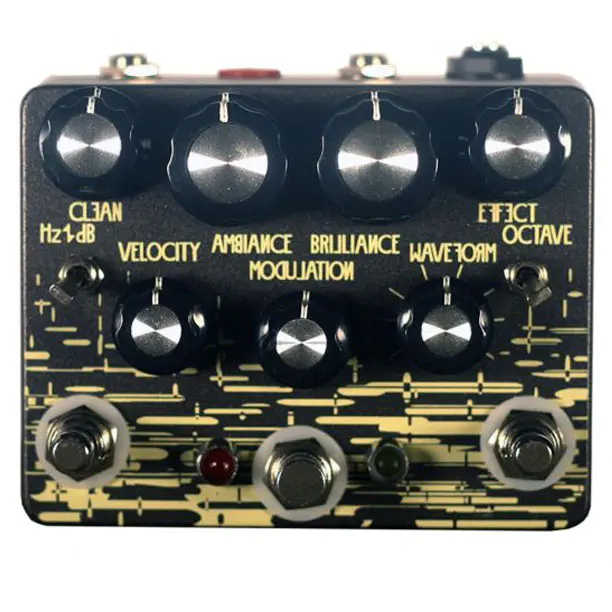
The Hungry Robot Borderland is a complex, creative reverb pedal with a modulation section controllable via Tap Tempo and a resonant low pass filter.
The modulation has 6 LFO shapes and features modes including vibrato/chorus, tremolo, three-octave tremolo, and a mode that crossfades between a processed signal an octave up from the input signal. The third pedal prolongs the reverb (sustain) and a CV In allows easy integration with modular systems.
An internal dip switch allows the algorithm to be changed from reverb to delay!
There’s also a more affordable Borderland lite version with only the reverb section.
Check out the videos of the Hungry Robot Borderland, we added it to our articles about the best hybrid reverb pedals and the best pedals with CV In.
The Borderland is an advanced digital reverb with a versatile tap tempo LFO/modulation section. At its core, is a reverb algorithm designed specifically with an ambient player in mind. It has an adjustable low-pass filter to alter the character of the reverb, ranging from small room reverb to a cavernous, dark hall reverb.
There are 8 LFO waveforms to choose from and 4 unique modulation modes (tremolo, chorus, triple octave tremolo, and octave slide). Set the LFO rate manually by using the “Velocity” knob or using the tap tempo option (right footswitch).
The left footswitch sends the pedal into near infinite sustain with the trails teetering on the edge of self-oscillation. The “Effect” and “Clean” knobs allow you to independently dial in the perfect ratio of wet and dry signals. Adjusting the “Ambiance” and “Brilliance” knobs sets the length of decay and the cutoff frequency of the onboard low pass filter.
The Borderland is the perfect pedal for creating lush, modulating, ambient textures.
Modulation Modes
The four modulation modes can be accessed through different toggle switch combinations.
Tremolo
Left Toggle – dB / Right Toggle – OFF
LFO affects the volume of the reverb signal, creating a tremolo effect
Chorus
Left Toggle – HZ / Right Toggle – OFF
LFO affects the pitch of the reverb signal, creating a chorus effect
Triple Octave Tremolo
Left Toggle – dB / Right Toggle ON
Three Octaves of Reverb, LFO affects volume of reverb, creating a vintage organ effect
Octave Slide
Left Toggle – HZ / Right Toggle ON
LFO crossfades between original pitch and octave up, creating an octave slide effect
Knobs
“Clean” – Sets the volume of the original dry signal
“Ambiance” – Sets the overall decay of the reverb trails
“Brilliance” – Sets the cutoff frequency of the low pass filter
“Effect” – Sets the volume of the wet reverb signal
“Velocity” – Manually sets the LFO rate
“Modulation” – Sets the depth of the modulation
“Waveform” – Sets the waveform type. The 8 waveforms are listed on the back of the pedal.
Footswitches
Left – Sends the pedal into near infinite sustain
Middle – Master On/Off
Right – Tap Tempo
Other
“Secret Mode” – There is a secret mode that can be selected internally by way of a dipswitch. This mode replaces the reverb code with delay code. The LFO section applies the same 4 modulation types to the delay section. The “Ambiance” knob is now delay feedback and the “Brilliance” knob is now delay time.
“Clock Input” – The clock input can received traditional tap tempo or 5V modular clock signals (gates/triggers).
Switching: True-Bypass
Dimensions: 4.7” x 3.7” x 1.96”
Powering: 9V DC – Negative Center – 2.1mm Barrel






















